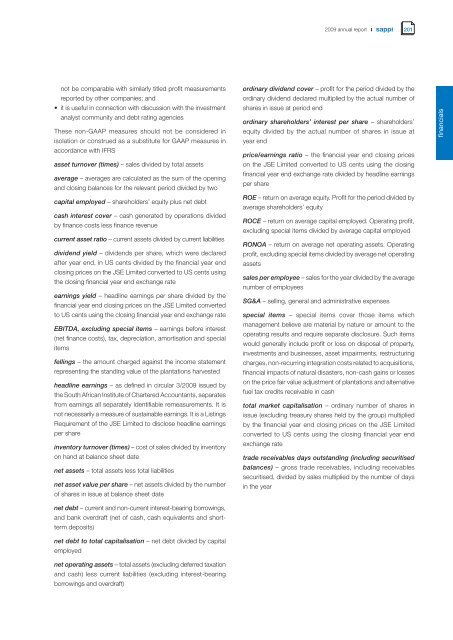Our performance in 2009 - Sappi
Our performance in 2009 - Sappi
Our performance in 2009 - Sappi
You also want an ePaper? Increase the reach of your titles
YUMPU automatically turns print PDFs into web optimized ePapers that Google loves.
not be comparable with similarly titled profit measurements<br />
reported by other companies; and<br />
• it is useful <strong>in</strong> connection with discussion with the <strong>in</strong>vestment<br />
analyst community and debt rat<strong>in</strong>g agencies<br />
These non-GAAP measures should not be considered <strong>in</strong><br />
isolation or construed as a substitute for GAAP measures <strong>in</strong><br />
accordance with IFRS<br />
asset turnover (times) – sales divided by total assets<br />
average – averages are calculated as the sum of the open<strong>in</strong>g<br />
and clos<strong>in</strong>g balances for the relevant period divided by two<br />
capital employed – shareholders’ equity plus net debt<br />
cash <strong>in</strong>terest cover – cash generated by operations divided<br />
by f<strong>in</strong>ance costs less f<strong>in</strong>ance revenue<br />
current asset ratio – current assets divided by current liabilities<br />
dividend yield – dividends per share, which were declared<br />
after year end, <strong>in</strong> US cents divided by the f<strong>in</strong>ancial year end<br />
clos<strong>in</strong>g prices on the JSE Limited converted to US cents us<strong>in</strong>g<br />
the clos<strong>in</strong>g f<strong>in</strong>ancial year end exchange rate<br />
earn<strong>in</strong>gs yield – headl<strong>in</strong>e earn<strong>in</strong>gs per share divided by the<br />
f<strong>in</strong>ancial year end clos<strong>in</strong>g prices on the JSE Limited converted<br />
to US cents us<strong>in</strong>g the clos<strong>in</strong>g f<strong>in</strong>ancial year end exchange rate<br />
EBITDA, exclud<strong>in</strong>g special items – earn<strong>in</strong>gs before <strong>in</strong>terest<br />
(net f<strong>in</strong>ance costs), tax, depreciation, amortisation and special<br />
items<br />
fell<strong>in</strong>gs – the amount charged aga<strong>in</strong>st the <strong>in</strong>come statement<br />
represent<strong>in</strong>g the stand<strong>in</strong>g value of the plantations harvested<br />
headl<strong>in</strong>e earn<strong>in</strong>gs – as def<strong>in</strong>ed <strong>in</strong> circular 3/<strong>2009</strong> issued by<br />
the South African Institute of Chartered Accountants, separates<br />
from earn<strong>in</strong>gs all separately identifiable remeasurements. It is<br />
not necessarily a measure of susta<strong>in</strong>able earn<strong>in</strong>gs. It is a List<strong>in</strong>gs<br />
Requirement of the JSE Limited to disclose headl<strong>in</strong>e earn<strong>in</strong>gs<br />
per share<br />
<strong>in</strong>ventory turnover (times) – cost of sales divided by <strong>in</strong>ventory<br />
on hand at balance sheet date<br />
net assets – total assets less total liabilities<br />
net asset value per share – net assets divided by the number<br />
of shares <strong>in</strong> issue at balance sheet date<br />
net debt – current and non-current <strong>in</strong>terest-bear<strong>in</strong>g borrow<strong>in</strong>gs,<br />
and bank overdraft (net of cash, cash equivalents and shortterm<br />
deposits)<br />
net debt to total capitalisation – net debt divided by capital<br />
employed<br />
net operat<strong>in</strong>g assets – total assets (exclud<strong>in</strong>g deferred taxation<br />
and cash) less current liabilities (exclud<strong>in</strong>g <strong>in</strong>terest-bear<strong>in</strong>g<br />
borrow<strong>in</strong>gs and overdraft)<br />
<strong>2009</strong> annual report<br />
201<br />
ord<strong>in</strong>ary dividend cover – profit for the period divided by the<br />
ord<strong>in</strong>ary dividend declared multiplied by the actual number of<br />
shares <strong>in</strong> issue at period end<br />
ord<strong>in</strong>ary shareholders’ <strong>in</strong>terest per share – shareholders’<br />
equity divided by the actual number of shares <strong>in</strong> issue at<br />
year end<br />
price/earn<strong>in</strong>gs ratio – the f<strong>in</strong>ancial year end clos<strong>in</strong>g prices<br />
on the JSE Limited converted to US cents us<strong>in</strong>g the clos<strong>in</strong>g<br />
f<strong>in</strong>ancial year end exchange rate divided by headl<strong>in</strong>e earn<strong>in</strong>gs<br />
per share<br />
ROE – return on average equity. Profit for the period divided by<br />
average shareholders’ equity<br />
ROCE – return on average capital employed. Operat<strong>in</strong>g profit,<br />
exclud<strong>in</strong>g special items divided by average capital employed<br />
RONOA – return on average net operat<strong>in</strong>g assets. Operat<strong>in</strong>g<br />
profit, exclud<strong>in</strong>g special items divided by average net operat<strong>in</strong>g<br />
assets<br />
sales per employee – sales for the year divided by the average<br />
number of employees<br />
SG&A – sell<strong>in</strong>g, general and adm<strong>in</strong>istrative expenses<br />
special items – special items cover those items which<br />
management believe are material by nature or amount to the<br />
operat<strong>in</strong>g results and require separate disclosure. Such items<br />
would generally <strong>in</strong>clude profit or loss on disposal of property,<br />
<strong>in</strong>vestments and bus<strong>in</strong>esses, asset impairments, restructur<strong>in</strong>g<br />
charges, non-recurr<strong>in</strong>g <strong>in</strong>tegration costs related to acquisitions,<br />
f<strong>in</strong>ancial impacts of natural disasters, non-cash ga<strong>in</strong>s or losses<br />
on the price fair value adjustment of plantations and alternative<br />
fuel tax credits receivable <strong>in</strong> cash<br />
total market capitalisation – ord<strong>in</strong>ary number of shares <strong>in</strong><br />
issue (exclud<strong>in</strong>g treasury shares held by the group) multiplied<br />
by the f<strong>in</strong>ancial year end clos<strong>in</strong>g prices on the JSE Limited<br />
converted to US cents us<strong>in</strong>g the clos<strong>in</strong>g f<strong>in</strong>ancial year end<br />
exchange rate<br />
trade receivables days outstand<strong>in</strong>g (<strong>in</strong>clud<strong>in</strong>g securitised<br />
balances) – gross trade receivables, <strong>in</strong>clud<strong>in</strong>g receivables<br />
securitised, divided by sales multiplied by the number of days<br />
<strong>in</strong> the year<br />
f<strong>in</strong>ancials
















